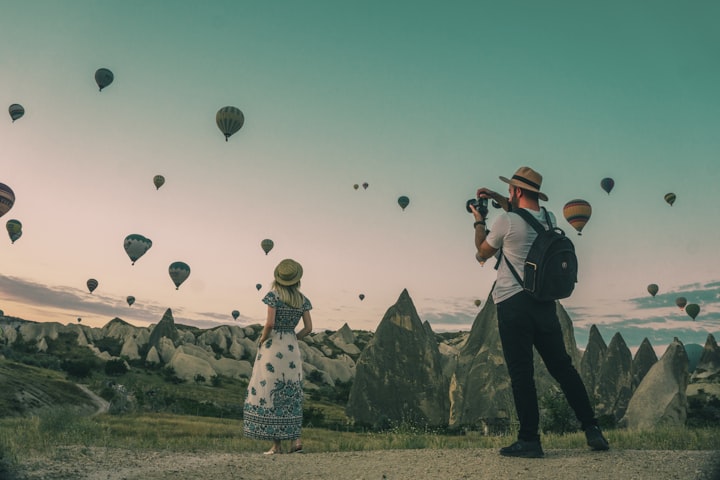Landscape Photography: A Complete How-to Guide in 2021
Landscape photography is challenging to master, but a high-paying profession. This article provides some tips that help you get the expertise.

Landscape photography is the most satisfying and lovely form of photography. Taking pictures of nature might sound simple when surrounded by serene beauty. But when it comes to capturing the best and share-worthy ones, it is much more than clicking pictures.
Once you comprehend the basic concepts of landscape photos, it helps you capture the best.
In this blog, we present some landscape photography tips that might benefit your next nature photo shoot.
Select the Right ISO Settings
When you choose higher ISO settings, the images can have more noise or grains. So, setting low ISO enables you to click photos with correct shutter speeds and aperture. You can choose your ISO settings to be in the range of 100-400 to have good results. But if the situation demands a higher ISO range, there is no need to worry about the image quality.
Choose Mid-Range Aperture Settings
Landscape photography aims to get clear and sharp images of exceptional quality. So, it has close connections with exposure, starting with setting the right aperture. The correct settings can generate high-definition images. Professionals recommend a mid-range aperture of f/8 to have high clarity images. A front or back leap in the aperture range can minimize the quality of the pictures.
Use a Tripod if Necessary
After setting the aperture and ISO, select the shutter speed for the correct exposure. You can make this process simple to the core. Just put your camera in the aperture mode when you set the aperture. As a result, the camera auto-selects the shutter speed needed for accurate exposure.
Sometimes you might need low shutter speeds. These low speeds can cause some hand trembles that result in distorted or shaky images. When you use a tripod, it eliminates any shakes caused by the shutter speeds or hand.
So, how to determine the lowest shutter speed for hand-held cameras? It is simple: see the lens focal length and the reciprocal of that number is the slowest shutter speed.
Polarizing Filter Works Well.
Many photographers use polarizing filters to improve color and contrast and lessen glares. The filter is useful to capture images that have reflections, sky, water, or rich colors.
The polarizing filter helps reduce the glare of trees on water or capture the true colors of the vibrant blue sky.
These rotatable filters attached to the end of the camera help the photographers control polarizing levels. Besides, these filters act as a shield for your camera lens against scratches.
If you use a mobile phone or point-and-shoot camera, then attaching this filter is not possible. In this case, you can use polarized sunglasses to get similar results.
Schedule Your Photo shoot During the Golden Hour.
The time after the sunrise or before the sunset is the golden or magic hour. It is due to the diffused light effect that is created with low-key technique. When the sun is down on the horizon, the surrounding tends to have a warm glow that helps you click long shadows. These types of settings add depth to your images.
But these facts do not mean that you cannot take landscape images during any other time of the day. During the afternoon, the sun is high on the horizon and it will have a harsh and glaring effect. It is not an appropriate setting to capture the best images.
Here, you can look for some other alternatives for clicking good pics. You can wait until the cloud covers the sky so the natural light will be soft and not harsh. You can also zoom into the closer objects for the best shots.
Composition Matters
What makes landscape photos eye-catching? It is a good composition of all elements like the sky, trees, mountains, water, or anything. Below we have listed some proven ways that scale up the structure of these serene scenes.
a. Rule of Thirds
Do you remember it? Yes, it is this simple rule that helps to create well-composed pictures. How to do it? We have re-phrased this technical rule into an easy-to-understand format. Take your image and divide them into three equal parts horizontally and vertically with imaginary grid lines. Then position the elements or subjects along the lines or at the intersection of two lines.
You can do this with ease with a viewfinder that is present by default in many cameras.
b. Use Leading Lines.
These are visible lines that guide your vision through the image to a specific area of interest. It adds a movement to the pic which removes the flat feel.
c. Alter Your View Point.
Photographers have the habit of standing and clicking pictures only from head heights. It is a great way to take photos. But when you change your viewpoint, it can add spark to your pics. While shooting, try getting pics from a bird’s-eye view or kneel/lie down to get a worm’s eye view. Besides, you can even try shooting from the hip height and examine what you get at the end.
Another great idea to change the viewpoint is to shoot the subject from a varying distance. You can step in close to the element and shoot with your camera. Then glance at those pictures to find out whether it has those wow factors you expected.
Use Raw Format.
When you use RAW files instead of JPEG, it helps you hold more information. Many prefer to use JPEG format to save up their image files on the camera. But they can lose some vital information necessary for post-production photo editing. These RAW files provide accurate details for color balance and exposure. It, in turn, facilitates a smooth work process.
Prep Tips for Clicking Good Photos (Landscape, of course!)
a. Know the Camera Features
What is your camera type? Mobile camera, Point-and-shoot camera, or DSLR? Regardless of which type you use, it is better to know the technical features of the camera. It helps you use your equipment to the fullest.
b. Camera Defaults for Landscape Photos
Some cameras do not permit to change aperture, shutter speed, and ISO. In that case, you can use the auto settings in the cameras for capturing the landscapes. These settings will auto-adjust the aperture and shutter speeds. It, in turn, helps you snap some vibrant colors.
c. Do Your Location Research
If you have a photo shoot at a place where you have never been, it is great to do some online research before. Search for more viewpoints and other serene areas. Spend some time using Google Street Views to have some virtual views of the scene. This information can give a shape to your photo shoot before starting the journey. Now, you will know what to expect from your camera.
d. Visit the Location
Professionals tend to go to the location beforehand several times. It helps them to get an idea of how the place will look like during different lighting conditions. Also, it lets you decide when to get to the spot to click that magical shot.
When the photo shoot is not pre-planned, try to be patient to get the best position for good results. You can plan to reach the high-altitude lake close enough to the magic hour to get the best shots. During the hike time, you can decide upon the camera setting and other factors for your photo shoot.
We hope that this blog has provided some insights into the most enjoyable form of photography.
Are you a travel photographer looking for some drone photo editing for your RAW images? Then do visit our website and try our free trial before entrusting us with your treasured photos.
About the Creator
Graham Smith
BDM at WinBizSolutionsIndia a business process outsourcing company, provides support to global clientele in the areas of call center, photo editing, graphic designing, 3d design, animation and eBook conversion services.






Comments
There are no comments for this story
Be the first to respond and start the conversation.